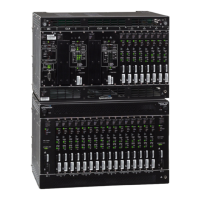097-55501-01 Revision M – January 2009 TimeHub 5500 User’s Guide 29
Chapter 1 Description
Functional Overview
Clock Cards
Clock cards provide input monitoring, selection, and holdover. Two types of Clock
cards are available for the TimeHub 5500:
Standard Clock cards: These cards are equipped with five inputs (four DS1 and
one 5/10 MHz) and do not support Expansion shelves.
– Five-input with an ST2 rubidium oscillator (090-55513-01)
– Five-input with an ST3E quartz oscillator (090-55511-01)
Extended-capacity Clock cards: These cards are equipped with nine inputs (four
DS1, four monitoring inputs, and one 5/10 MHz) and support Expansion shelves.
If you plan to use an Expansion shelf (or shelves) attached to a Master shelf, you
must use extended-capacity Clock cards.
– Nine-input with an ST2 rubidium oscillator (090-55514-02)
– Nine-input with an ST3E quartz oscillator (090-55512-02)
Two Clock cards are required for redundancy; oscillator types can be mixed.
Each Clock card receives the input reference signals from the Input/Alarm
Connector card, determines their quality for use by the system, and selects the most
appropriate input signal to use as the active reference. During normal operation, the
active clock tracks the active input signal, and produces a precise frequency for the
Output Driver cards based on the input reference. The standby clock does the same
thing except its output is not used by the Output Driver cards. The standby clock
backs up the active clock, ready to become active when necessary.
If the input reference is disqualified, the Clock card selects another qualified input
signal as the reference. If no input references are qualified, the Clock card goes into
holdover, using its own oscillator as the system reference.
For detailed information on Clock cards, see Clock Cards, on page 50.
Management Card
The Management card manages alarms to and from the TimeHub 5500, and
provides local and Ethernet LAN communication interfaces. The TimeHub 5500 can
operate without a Management card installed, but you will lose any communications
abilities, alarms, and the Passthrough feature.
If an alarm condition occurs, the Management card determines whether the alarm
state is critical, major, or minor, actuates the corresponding alarm relays, causes the
appropriate LEDs to light, and generates TL1 alarm message(s) via the local or LAN
communication interface. For more detailed information on the Management card,
see Management Card, on page 54.

